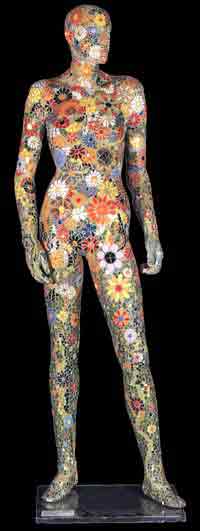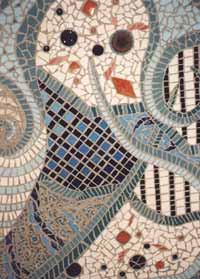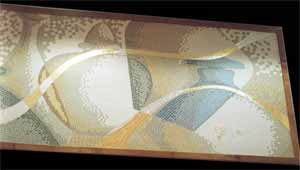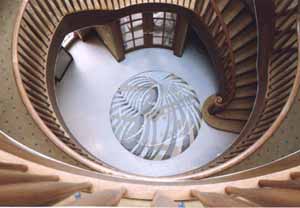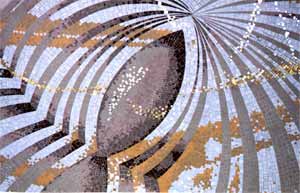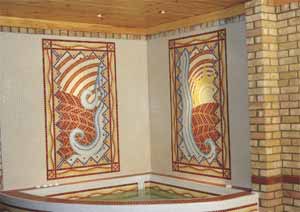
 |

THE MOSAIC STUDIOPAUL SIGGINS AND PAUL COOPER |
Mesdames et Messieurs, behold, La Nature Girl. A pique assiette lorry-stopper. She wowed them at the 2nd International Mosaic Symposium at Chartres in 1998; one petit garçon chatted her up for 30 minutes. She had only just returned in triumph to Leigh-on-Sea when I arrived for my visit to her creators, Pauls Siggins and Cooper, who made her out of sixties and seventies tile applied to a retired mannequin. There is in fact a tradition of "mosaiced furniture" in France, which reached its apotheosis in Raymond Isidore's Chartres house, covered within and without in broken china mosaic. The effect is, it seems, very Victorian claustrophobic; it is anti-minimalist with a vengeance. But the Isidore house is a rare example of the whole body of an artist's output assembled in one place. (See Leslie Dierks's Making Mosaics, p.15, and MM15, p.4) The invitation to attend the show and give a lecture came as direct result of the success in France of Mosaic Studio's book for beginners, The Mosaic Sourcebook (30,000 sold world-wide to date). Among the many intriguing aspects of the exhibits by 150 mosaicists was that the amateur work was often more inspiring and inventive than that of many of the professionals, which should please quite a few of our subscribers. The two Pauls spoke on the practice of mosaic in Britain today, making the point that one encouraging development is that joe public is now meeting true mosaic not just in churches and museums, but in everyday places like shopping malls and subways. One artist they met was actually worried that the current wave of enthusiasm for mosaic, "the nineties' renaissance", might militate against the production of great art in the medium. But masterpieces would always surface, surely, even if the entire population took up mosaic? What made Paul Siggins take up mosaic was his dad. He was a tile fixer, and took his son on as an apprentice (with O Level Maths, Art, and Technical Drawing, very useful this last) from the age of 15 to 20. On top of that Uncle Barry made and sold stained glass, and Paul worked for him as well, before setting up on his own.
One of Paul's first mosaic jobs was making a cut tile floor for Manoly's in Leigh-on-Sea, now a Thai restaurant. He used pretty large pieces for that, and since then has gradually dwindled into doing mosaic proper. Other jobs followed, and he found that he enjoyed using natural materials like marble, slate and other stones. A significant break-through came when the fashion chain Wallis asked him to do a mosaic for one of their window displays. The great thing about this kind of work is that more often than not the clients positively demand unconventional, eye-catching, in-your-face pieces. One thing led to another, and Paul went on to make panels, vases, urns, mirrors, etc., for various Wallis displays. Commissions from other shops quickly followed: Selfridges, Harvey Nicholls, Simpsons, Dickens and Jones, Liberty. Paul Cooper, an old friend, joined the firm halfway through the series, in late 1992. He was supposed to be in charge of the marketing: mail shots, hunting up new clients, all that. In fact the above ball was already rolling to such an extent that he was asked to lend a hand making mosaics, not selling them. He felt able to do so, because although he had a background in the not frightfully artistic business of accounts, quantity surveying, banking and advertising agencies, he did have A Level Art and History of Art, and had always painted and made collages in his spare time. And as we all know, the basic techniques for making mosaics can be picked up very quickly. It is now Fiona, Paul Siggins' wife, who does the marketing and the accounts.
I was particularly interested in a 6 x 1.2 metre mosaic they did for the Argyll Street entrance to the Dickens and Jones store, opposite the Palladium. This was a case where the clients initially gave them a free hand, but the design changed quite dramatically as the clients realised what they didn't want. The first draft incorporated various elements of the store as a whole, and was in bold colours. Then it was decided to concentrate on one element only, the perfumes on sale. So now you had Lalique bottles, in long shot. Then the clients thought they preferred subtle colours to bold, as they didn't want the customers to be so lost in admiration of the mosaic as to be distracted from purchasing perfume and other products. Next, close-ups of bottles were included, as well as long shots. Finally, ribbons of colour, to bind the whole scene together. 20 drawings, 10 finished paintings - the full story of the evolution of this mosaic would be a study in itself. It was made from Cinca ceramic, plus gold and silver, direct onto ply. The grout was one the Pauls often use: ivory Bal Wide Joint, which has an attractively grainy texture.
They are well aware of the distinction between mosaic as decorative art and mosaic as fine art, and the lure of the latter is strong. Happily, they are sometimes able to satisfy the urge, most recently in a mosaic for a wealthy client who wanted a floor for the circular hall of his new home. A few colour desiderata, but apart from that, carte blanche. There was a glass dome above the spiral staircase, and so the mosaic was designed not only as an abstract version of the structure surrounding it, but also as the embodiment of light, constantly changing light, cast shadows and moving vessels. A major bonus was that for once you could look down on the mosaic from a fair height, and appreciate it as a whole. Cinca again, with thick-glass gold and silver.
They got another chance to spread their wings when a customer requested mosaics for his indoor pool and jacuzzi. He regularly visits South Africa, and so Mosaic Studio came up with abstract images of earth and sun and water. The deep, rich reds were tesserae cut from glazed Harmonie tiles, which have a wide range of tone within a given tile colour. Naturally, Mosaic Studio work not only with ceramics and old tiles (of which they have a mouth-watering collection) but with stone, vitreous, smalti, and with mirror tesserae that were new to me. These are called Mirror-Flex, and come in one-inch squares. They are available in clear mirror, but also in mottled, peach and grey shades. (They can be ordered through the Studio.) How do the Pauls work together? Siggins does the initial measuring-up, but developing the design is usually a joint effort, bouncing ideas off each other. When they come to making the mosaic itself they do their best to make sure their different "hands" are concealed. One will do the outermost border of a circular pattern, for example, the other the next ring in, and so forth. I was able to check this out by inspecting their most recent job, which involved using the indirect method to replicate a damaged circular floor mosaic, 6½ metres in diameter, for a shopping mall. This had been a major challenge, as the original "opus" style was most unusual: the tesserae consisted of units about an inch square, plus ½-units, plus ¼-units. The challenge was to make the mosaic with as little extraneous tesserae-nipping as possible, no matter how curvaceous or detailed the design might be. Tricky. Opus horribilis.
Incidentally, for this mosaic they first made up their own template, and sent an identical copy of it to the builders in the shopping mall, to ensure that the finished mosaic would fit snugly into its bed. Clever. But six months of reproducing someone else's work left them hungry to get back to creating their own. Cooper wants to do some small Pop Art panels as a change from large scale mosaics, and Siggins - a Gaudi fan - would like to do a big, maybe very big, exterior wall, perhaps as a community project. The two Pauls are not clones. PB. The
Mosaic Studio, 54 Darlington Grove, |
All
content is copyright of © Mosaic Matters and its contributors.
All rights reserved
Mosaic
Matters is:
Editor: Paul Bentley
Web Manager/Designer: Andy Mitchell

